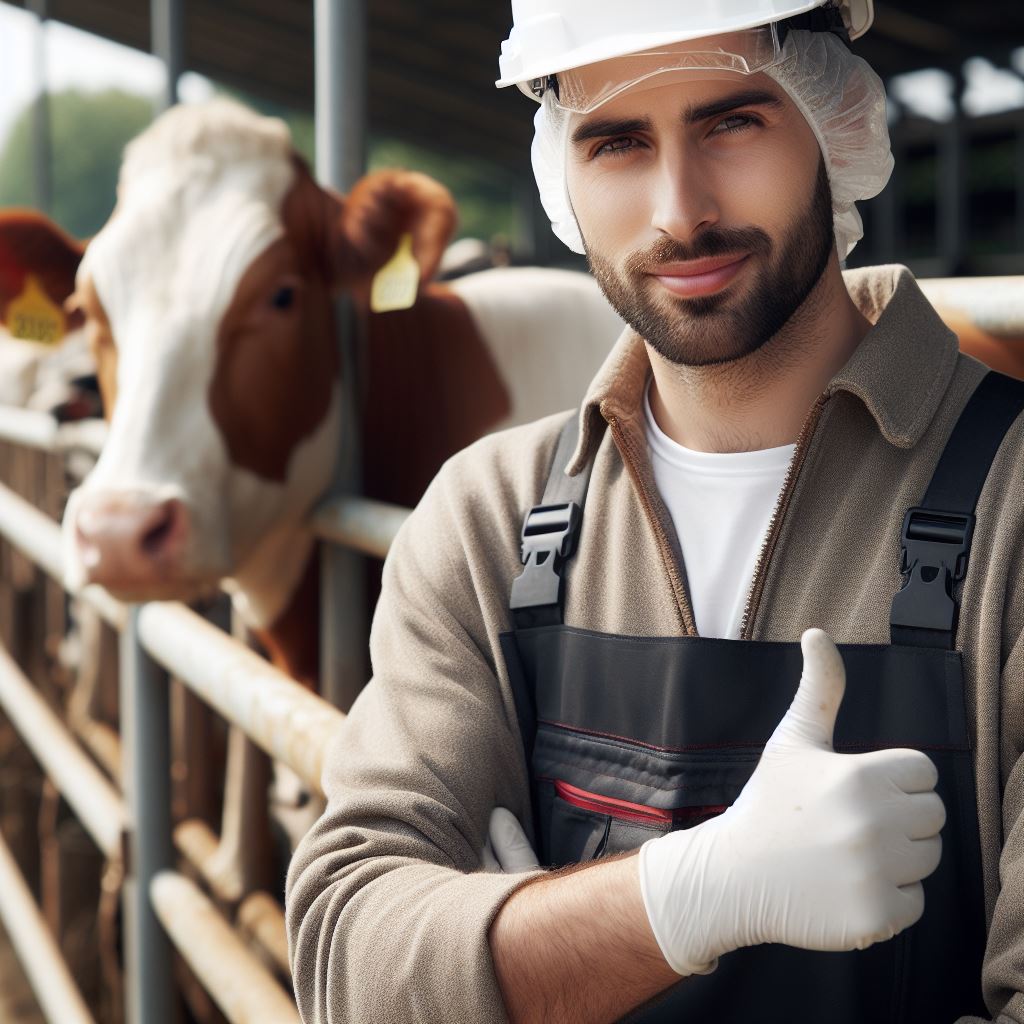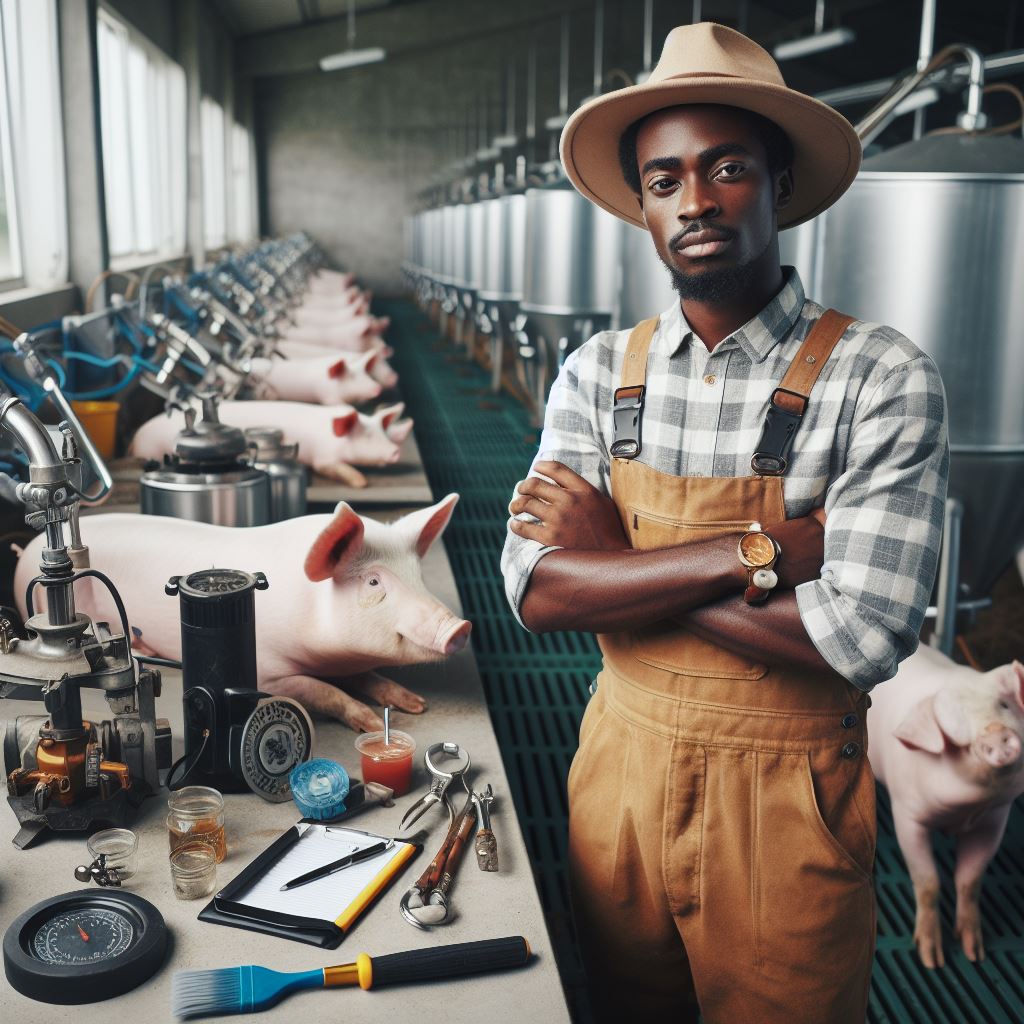Introduction
Cost-effective feeding systems are essential for small farms to ensure profitability and sustainability.
Implementing efficient feeding practices can significantly reduce expenses and maximize productivity.
One cost-effective feeding system for small farms is rotational grazing, where animals are moved to fresh pastures regularly.
This method allows for better forage utilization and prevents overgrazing and soil degradation.
Small farms can also adopt strip grazing, dividing pastures into sections and allocating them to animals daily.
Strip grazing promotes optimal forage consumption and minimizes waste.
Another approach is using portable electric fences and water systems, allowing flexibility in grazing management.
This system enables farmers to rotate pastures efficiently and provide water access throughout the grazing area.
Feeding animals with a well-balanced diet is crucial for cost-effectiveness.
Small farms can consider producing their own feed using locally available resources or partnering with nearby producers.
Additionally, reducing feed waste through proper storage, handling, and accurate feeding techniques is vital.
Monitoring feed intake and adjusting rations according to animal needs can optimize production and minimize costs.
In essence, implementing cost-effective feeding systems on small farms is crucial for their economic viability.
By adopting practices such as rotational grazing, strip grazing, and efficient feed management, small farms can thrive.
Traditional Feeding Methods
Brief overview of traditional feeding methods
- Most traditional feeding methods on small farms involve manually feeding animals using locally available feed.
- Farmers typically rely on grazing, kitchen scraps, and leftover crops as feed sources.
- Feeds are often supplemented with low-cost options such as hay, straw, or silage.
- Traditional feeding methods are labor-intensive and require manual handling and distribution of feed.
- These methods are often inefficient, leading to uneven distribution of feed and wastage.
Challenges and limitations of traditional feeding methods for small farms
- Limited availability of feed resources can lead to nutritional deficiencies in animals.
- Manually feeding animals is time-consuming and requires significant labor input.
- Uneven distribution of feed can result in competition between animals and dominant individuals getting more feed.
- Lack of proper storage facilities for feed can lead to spoilage and loss.
- Inefficient traditional feeding methods may not meet the nutritional requirements of high-performing animals.
Need for alternative cost-effective feeding systems
- Small farms need cost-effective feeding systems that improve efficiency and reduce labor requirements.
- Alternative feeding systems can help optimize the use of available feed resources and reduce wastage.
- Automated feeding systems ensure consistent and accurate distribution of feed to all animals.
- Effective storage facilities ensure proper preservation of feed, reducing spoilage and loss.
- Cost-effective feeding systems provide better control over the nutritional needs of animals, improving overall productivity and profitability.
Alternative feeding systems allow small farmers to overcome the limitations of traditional feeding methods.
Transform Your Agribusiness
Unlock your farm's potential with expert advice tailored to your needs. Get actionable steps that drive real results.
Get StartedThese systems help optimize the use of available feed resources, minimize labor requirements, and improve overall productivity.
feeding system
One popular cost-effective feeding system for small farms is the use of self-feeders. Self-feeders are designed to provide free-choice access to feed throughout the day.
They eliminate the need for manual feeding, saving valuable time and labor.
Another alternative feeding system is the implementation of rotational grazing. This involves dividing pastures into smaller paddocks and rotating animals between them.
It allows for better utilization of grass and forage, reducing the need for supplementary feeds and optimizing the natural grazing behavior of animals.
Additionally, small farmers can explore the use of hydroponic fodder systems.
These systems allow the cultivation of nutrient-rich sprouted grains indoors, providing a consistent and reliable source of feed throughout the year.
Investing in proper feed storage facilities is also crucial for small farms.
Silos or other types of storage structures ensure the preservation of feed quality and reduce spoilage and waste.
Efficient storage facilities help farmers save on feed costs in the long run.
Generally, traditional feeding methods on small farms have several challenges and limitations. However, alternative cost-effective feeding systems offer solutions to overcome these challenges.
Implementing self-feeders, rotational grazing, hydroponic fodder systems, and investing in proper storage facilities can significantly improve efficiency, reduce labor requirements, and enhance the overall productivity and profitability of small farms.
Grazing System
Explanation of a grazing system
A grazing system refers to a method of raising livestock where animals feed on fresh pasture.
Benefits of grazing systems for small farms
- Improved animal health: Grazing allows animals to consume nutrient-rich grass, promoting their overall well-being.
- Cost-effective: Grazing systems reduce the need for purchasing expensive animal feed.
- Efficient land use: Livestock can utilize the available pasture land more effectively with a grazing system.
- Environmental sustainability: Grazing systems can enhance soil fertility and reduce the need for chemical fertilizers.
How to establish and manage a grazing system
- Determine the carrying capacity: Assess the number of animals the pasture can sustainably support.
- Divide pastures into paddocks: Create multiple grazing areas to rotate animals and give pastures time to recover.
- Develop a grazing schedule: Set specific time periods for animals to forage in each paddock.
- Monitor water availability: Ensure there is sufficient water access in each grazing area.
- Implement fencing and infrastructure: Install appropriate fencing and provide shade or shelter for the animals.
Cost-saving potential of grazing systems
- Reduced feed costs: Grazing systems significantly reduce the need for expensive purchased animal feed.
- Lower labor requirements: Properly managed grazing systems can minimize the labor needed to feed animals.
- Decreased veterinary expenses: Animals on a grazing system tend to have improved health and require fewer veterinary interventions.
- Improved weight gain and productivity: Grazing on fresh pasture can enhance animal growth and productivity.
Therefore, utilizing a grazing system on small farms offers numerous benefits and cost-saving potentials.
By understanding the principles involved in establishing and managing a grazing system, farmers can ensure the health and productivity of their livestock while optimizing their resources.
Embracing grazing systems promotes sustainable farming practices and can lead to long-term success for small farm operations.
Silage Feeding System
Introduction to silage feeding systems
Silage feeding systems are a cost-effective option for small farms to provide nutritious feed to their livestock.
Silage refers to fermented forages that are stored in silos or other airtight containers.
These systems involve the process of producing, storing, and feeding silage to animals.
Advantages of using silage for small farms
Using silage as a feeding option offers several advantages for small farms.
- Preserves Nutrients: Silage retains more nutrients compared to drying and baling methods.
- Year-round Availability: Silage can be produced during the growing season and stored for year-round feeding.
- Reduced Labor: Once silage is prepared, it requires less labor compared to other feeding methods.
- Cost Savings: Silage production saves money by utilizing surplus forages and reducing wastage.
- Increased Animal Performance: Silage provides higher-quality nutrition, leading to improved animal health and productivity.
Steps to produce and store silage effectively
- Crop Selection: Choose suitable forage crops with high nutritional value and moisture content.
- Harvesting: Cut the crop at the right stage of growth and chop it into small pieces for better fermentation.
- Fermentation: Pack the chopped crop tightly into an airtight silo or container to promote fermentation.
- Cover and Seal: Use a plastic cover and weigh it down with tires or sandbags to seal the silo and prevent air entry.
- Fermentation Period: Allow the silage to ferment for a minimum of three weeks for optimal preservation.
- Feeding: Use proper feeding equipment to remove silage from the silo and distribute it to the animals.
Costs associated with silage feeding systems
While silage feeding systems offer numerous benefits, there are costs involved in their implementation.
- Equipment: Investing in machinery like choppers, wagons, and packing machines can be expensive initially.
- Storage Facilities: Constructing or purchasing silos and airtight containers requires a significant investment.
- Maintenance: Regular maintenance of equipment and storage structures adds to the ongoing costs.
- Crop Production: Growing and harvesting suitable forage crops for silage production also incurs expenses.
- Feeding Equipment: Adequate feeding equipment like loaders or silage cutters may be needed for efficient distribution.
- Labor: While labor costs can be reduced compared to conventional methods, some labor is still required during harvesting and feeding processes.
Ultimately, silage feeding systems offer small farms a cost-effective and efficient way to provide nutritious feed to their livestock.
By understanding the steps involved in producing and storing silage effectively, farms can maximize the benefits while managing the associated costs.
Investing in appropriate equipment and storage facilities is crucial for long-term success with silage feeding systems.
Showcase Your Farming Business
Publish your professional farming services profile on our blog for a one-time fee of $200 and reach a dedicated audience of farmers and agribusiness owners.
Publish Your ProfileRead: Turkey Rearing 101: Basics for Beginners

TMR (Total Mixed Ration) Feeding System
Overview of TMR feeding systems
Total Mixed Ration (TMR) feeding systems are a comprehensive and cost-effective approach to feeding livestock on small farms.
This system involves combining various feed ingredients into a homogeneous mix, ensuring animals receive a balanced and nutritious diet.
Benefits of TMR feeding for small farms
- Improved Nutritional Balance: TMR feeding allows for precise control of nutrient content, ensuring animals receive the optimal diet for their growth and health.
- Increased Feed Efficiency: By blending different ingredients, TMR enables better utilization of nutrients, leading to improved feed conversion rates and reduced wastage.
- Enhanced Animal Health: The balanced nutrition obtained through TMR feeding results in healthier livestock, with reduced incidences of metabolic disorders and improved overall well-being.
- Simplified Feeding Process: Implementing a TMR feeding system streamlines daily feeding routines, saving time and labor for small farm operators.
- Fosters Uniform Growth: TMR feeding promotes consistent growth among animals, leading to more uniformity in weight and size, which is beneficial for market purposes.
Components and preparation of a TMR
- Forage: High-quality forage, such as hay or silage, forms the foundation of a TMR. It should be properly harvested, stored, and processed to ensure optimum nutritional content.
- Concentrates: Grains, protein sources, and essential supplements, like vitamins and minerals, are added to the TMR mix to meet the specific requirements of the animals.
- Mixing Equipment: A TMR mixer, either vertical or horizontal, is used to combine the forage and concentrates thoroughly. The mixer’s capacity should match the size of the herd to ensure efficient mixing.
- Ration Formulation: The correct proportions of forage and concentrates are determined based on animal needs, and the ingredients are weighed and added to the mixer.
- Mixing Procedure: The forage is loaded into the mixer first, followed by the concentrates. The system should be programmed to mix for a sufficient duration to achieve a consistent blend.
Cost considerations when adopting a TMR feeding system
- Initial Investment: Acquiring a TMR mixer can be a substantial investment for small farms, but the long-term benefits outweigh the initial costs.
- Reduced Feed Costs: TMR feeding allows for more efficient use of feed ingredients and avoids unnecessary wastage, leading to potential savings in feed expenses.
- Health Savings: With improved nutrition and reduced incidences of diseases, the costs associated with veterinary care and medications can be significantly reduced.
- Labor Efficiency: Although the initial setup may require additional labor, a TMR feeding system ultimately saves time and effort by simplifying feeding routines.
- Increased Productivity: The overall benefits of TMR feeding, such as better growth rates and uniformity among animals, can lead to improved productivity and profitability for small farms.
Basically, implementing a TMR feeding system can be a game-changer for small farms.
It provides numerous benefits, including improved nutritional balance, enhanced animal health, simplified feeding processes, and cost savings.
By carefully considering the components, preparation, and cost considerations involved, small farm operators can make informed decisions to adopt TMR feeding systems and take their farming endeavors to new heights.
Read: Breeding Tech: New Trends in Livestock Genetics
Automatic Feeding Systems
Introduction to automatic feeding systems
- Automatic feeding systems offer efficient and convenient ways to nourish animals on small farms.
- These systems automate the feeding process, saving time and labor for farmers.
Advantages of automatic feeding systems for small farms
- Improved feed management: Automatic systems ensure accurate and consistent feed distribution.
- Time and labor savings: Farmers can focus on other farm tasks while the system handles feeding.
- Increased efficiency: Automatic systems reduce feed wastage and optimize animal nutrition.
- Enhanced animal health and performance: Precise feeding leads to healthier, more productive animals.
- Flexibility and customization: Farmers can program feeding schedules based on animal needs.
Different types of automatic feeding systems
- Conveyor belt systems: These systems use belts or chains to transport feed to troughs.
- Gravity systems: Feed is stored above the trough and released through gravity.
- Auger systems: Mechanical augers distribute feed to troughs.
- Robotics systems: Cutting-edge technology enables automated and precise feeding.
- Liquid feeding systems: Liquid feed is pumped to troughs using pipes and valves.
Cost analysis and ROI of automatic feeding systems
- Initial investment: Automatic feeding systems can be pricey, depending on the complexity and size.
- Cost savings: Reduced labor costs and decreased feed wastage contribute to long-term savings.
- Return on investment (ROI): Farmers should analyze the projected ROI over the system’s lifespan.
- Factors influencing ROI: Farm size, animal type, feed costs, and system efficiency impact ROI.
- Consult experts: Seek advice from specialists to determine the most cost-effective option for your farm.
Generally, automatic feeding systems provide numerous benefits for small farms. They streamline the feeding process, offering improved feed management, time savings, and increased efficiency.
Different types of systems cater to various farm needs, including conveyor belt, gravity, auger, robotics, and liquid feeding systems.
While the initial investment can be significant, the long-term cost savings and ROI make these systems an attractive option.
Farmers should consider factors such as farm size, animal type, feed costs, and system efficiency when determining the most suitable and cost-effective choice for their operation.
Read: Biosecurity in Livestock Farms: Key Practices
Comparison and Evaluation of Feeding Systems
Comparison of the various feeding systems discussed
When it comes to feeding systems for small farms, several options exist. Some popular ones include pasture grazing, confinement feeding, and semi-confinement systems.
Each system has its strengths and weaknesses.
Pasture Grazing
- Provides animals with the opportunity to graze on natural grass and forage.
- Reduces feed costs as animals rely on available vegetation.
- Requires extensive land and rotational grazing management.
- Suitable for farms with ample pasture resources and favorable climate conditions.
Confinement Feeding
- Involves keeping animals in enclosed spaces and providing them with a specific diet.
- Allows for close monitoring of animals’ nutrition and health.
- Requires significant investment in infrastructure and feed procurement.
- Ideal for farms with limited land resources or unfavorable weather conditions.
Semi-Confinement Systems
- Combines elements of both pasture grazing and confinement feeding.
- Animals have access to both grazing and supplementary feed.
- Offers flexibility and adaptability to varying farm conditions and animal requirements.
Factors to consider when choosing the most suitable feeding system for a small farm
To select the most appropriate feeding system for a small farm, it is crucial to consider the following factors:
Farm Size and Resources
- The size of the farm will determine the feasibility of certain systems.
- Availability of land, water, and facilities will also impact the choice.
Animal Breed and Type
- Different animal species have varying nutritional requirements.
- The feeding system should adequately meet these requirements for optimal growth and production.
Climate and Weather Conditions
- Climate influences the availability of grazing resources and impact on animal comfort.
- Suitable feeding systems should be adapted to the specific climate and weather patterns.
Economic Considerations
- The cost of implementing and maintaining each feeding system needs evaluation.
- Available budget and potential financial returns should be taken into account.
Labor Requirements
- Some feeding systems may demand more labor-intensive operations than others.
- The farm’s available workforce and their expertise should align with the chosen system.
Evaluation of the cost-effectiveness of each system
Determining the cost-effectiveness of feeding systems involves analyzing both initial investment and operational expenses. The following factors affect the cost-effectiveness of each system:
Feed Costs
- Some systems require purchasing additional feed, while others rely on existing forage.
- The availability and cost of feed sources must be considered.
Infrastructure and Equipment
- Building and maintaining infrastructure can be a significant expense.
- The necessary equipment for each system should also be evaluated for cost-effectiveness.
Animal Health and Productivity
- Effective feeding systems should support optimal animal health and productivity.
- The impact of each system on veterinary costs and overall profitability needs consideration.
Case studies/examples of small farms successfully implementing cost-effective feeding systems
To better understand the real-world application of cost-effective feeding systems, let’s explore two case studies:
Case Study 1: Grassland Farm
- Grassland Farm utilizes pasture grazing, rotational grazing management, and minimal supplemental feed.
- Reduced feed costs and high-quality animal products contribute to their cost-effectiveness.
- Their investment in fencing and water infrastructure resulted in improved grazing efficiency.
Case Study 2: Efficient Feedlot
- Efficient Feedlot practices a semi-confinement system with a balanced ratio of grazing and confinement.
- Careful feed formulation and efficient space utilization optimize their cost-effectiveness.
- Their investment in feeding infrastructure and feed procurement strategies significantly lowered costs.
In all, comparing and evaluating feeding systems for small farms requires considering various factors.
The choice should align with farm resources, animal requirements, climate conditions, and economic considerations.
Through analyzing cost-effectiveness and studying successful case studies, farmers can make informed decisions to ensure optimal results for their small farms.
Read: Aquaculture Health: Fish Disease Management
Conclusion
Recap of the importance of cost-effective feeding systems for small farms
Throughout this blog post, we have emphasized the significance of implementing cost-effective feeding systems on small farms.
These systems not only contribute to reducing expenses but also enhance the overall efficiency and productivity of the farm.
Final thoughts and key takeaways from the blog post
By adopting alternative feeding systems, small farmers can optimize their resources, improve animal health, and ultimately increase their profit. It is essential to evaluate the available options and select a feeding system that aligns with the specific needs and budget of the farm.
Call to action for small farmers to consider alternative feeding systems for cost savings and efficiency
As a small farmer, it is crucial to explore and implement alternative feeding systems that can provide significant cost savings and enhance operational efficiency.
Conduct research, seek advice from experts, and connect with other farmers to gain insights and guidance in selecting the most suitable feeding system for your farm.
Embrace innovation and find ways to maximize your productivity while minimizing costs.
By adopting cost-effective feeding systems, small farmers can ensure the sustainability and profitability of their farms for future generations.




